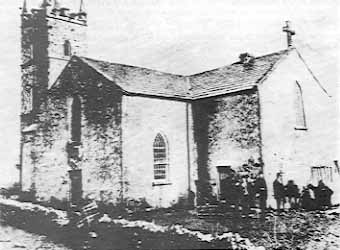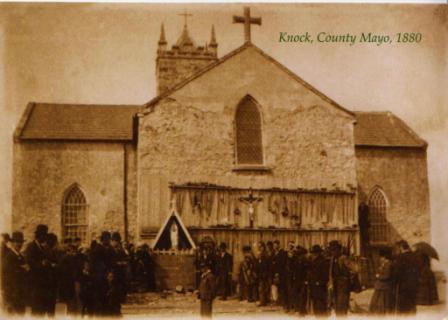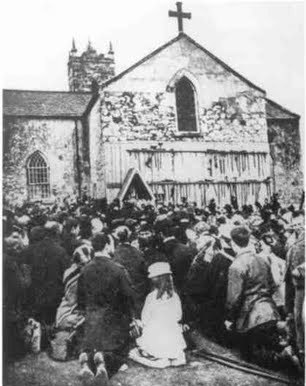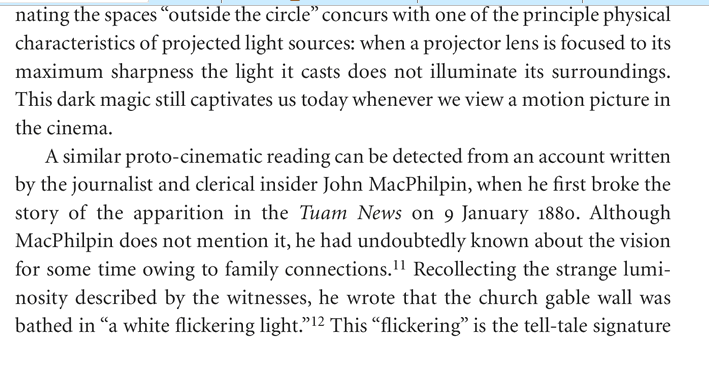EVIDENCE FOR A PROJECTOR BEING USED TO MAKE THE "APPARITION" AT KNOCK 1879
On the night of the 21st of August 1879 the Virgin Mary flanked by St Joseph and a bishop thought to be St John the Evangelist and an altar with a lamb and cross on it allegedly appeared on the gable wall of the Parish Church of Knock for a few hours. Fifteen people witnessed the vision including a child of five (page 60, The Evidence for Visions of the Virgin Mary). Witness statements were published in a highly altered and edited form that differed hugely from the real ones the witnesses made. That witnesses didn't do the slightest thing about the lies speaks strongly against them as honest people.
Evidence for a projector
Was the apparition at Knock caused by trickery?
Many suspected that it was caused by a magic lantern, a projector. Indeed in
1935, Liam Na Cadhain interviewed Mary Beirne then Mary O Connell and she
declared, "The light about the figures was not like any light I ever saw but
more like the soft silvery light of the moon" (page 50, The Apparition at
Knock). A soft light! This refutes the lying witnesses who swore the light was
very very bright. And it proves that it could have been the light that comes
from a magic lantern which would not be exceptionally bright.
Patrick Beirne in 1932, testified, "I saw three figures on the gable surrounded
by a wonderful light. They appeared to be something like shadows or reflections
cast on a wall on a moon-light night" (page 53, The Apparition at Knock). This
sounds like a perfect description of what a lantern would produce. Later in
August 1936, under oath he lied that the whole gable was as white as snow with
the brilliant light and that the figures were as clear and distinct as any human
being (page 54, The Apparition at Knock). He was known to be odd and consider
himself a person of some importance but generally truthful (page 55, The
Apparition at Knock). He liked to be held important. When he said that the light
was like moonlight and the apparitions like shadows that was the truth. Later he
embellished all this to be important.
Read http://www.novelguide.com/a/discover/eop_01/eop_01_02624.html
The book, The Apparition at Knock, A Survey of Facts and Evidence by Fr Michael
Walsh is a good read. Page 20 tells us that the figures seemed to move out and
then backwards according to Patrick Hill’s testimony. That is what something
being projected from a machine would do. Claims such as that the witnesses never
mentioned the beams of light that would come from a lantern, or mentioned that
shadows appeared as if they were standing in front of some light source so the
magic lantern idea is false are inconclusive. The witnesses didn't say
everything in their testimonies. They would not have liked to think about beams
and shadows and things if they had happened.
Objections Answered
There are objections to the magic lantern hoax theory.
A hoax apparition does not need to be made for two hours. Ten minutes would do.
- Nonsense if the time is too short people will put the vision down to
imagination or drink. The hoaxer had no idea how long it would take for people
to discover the images so he had to prepare the vision for two hours. He had to
allow time so that they could go away and bring people to see it.
Nobody in Knock is likely to have had a magic lantern.
- Who knows? And why not the priest?
And who would have a magic lantern that is able to keep up for two hours? What a
great power supply that was for 1879!
- The images were not as bright as some have alleged. Patrick Beirne said they
were like moonlight. A magic lantern could have managed that quite easily.
Perhaps the lantern was only projecting light onto images made of canvas.
The witnesses could have been duped by a projector as was rumoured at the time
and they would have pushed the evidence they noticed for this outside of their
minds in order that they could believe they really had a miracle vision. It has
been found that a light source such as a projector - a magic lantern - could
have been used. It may have been on the window sill and the image was then
directed at a mirror which shone it down the gable. This would have avoided the
problem of spectators getting in the way of the light source. But sceptics
observe that they strangely stood at an awkward viewing angle from a schoolhouse
at a distance as if they were trying to avoid disturbing the vision. It is said
that there is no evidence the witnesses got in the way of the light source. But
there is no evidence against it either. The witnesses were not asked anything
about it. But Hill did tell the Daily Telegraph in 1880 that he never looked
behind him to see where the light might have been coming from. For somebody
allegedly having stood at the gable for 1 and a half hours this is incredible.
It is more likely that he did look behind and wanted to forget it. Did he see a
light source?
It is claimed that at least some of the witnesses would have examined the scene
for a hoax and would have been smart enough to spot a hoax. But when one
considers how people can flock to venerate a tree stump that seems to have the
virgin's face on it, it is possible that they felt no inclination to check it
out. Also the witnesses were never asked if they saw anything suggestive of a
hoax. If they were it was never written down. Judith Campbell's testimony is
typical of most of the visionaries. She only states what was to be seen and says
nothing about a hoax never mind a miracle! Her account simply says she saw
statues and light around them. If the images were not that amazing that would
explain why the visionaries were too embarrassed to get all the neighbours out
to see it. The apparition was seen only by a few and most of them were related.
There is no evidence against the hoax theory.
Another objection is that if the vision was a set up, where did the hoaxers keep
or take their equipment and other props? That is an argument from ignorance and
it is no good. It is not a real objection. You cannot argue that Annie didn't
have a gun for where was she going to hide it?
There were four doors to Knock chapel, 3 on the western or road-side and one on
the eastern side of the church. See MEMORIES OF KNOCK IN THE EARLY NINETEENTH
CENTURY, Memoir of Daniel Campbell, Eden and Smethwick, written c. 1880.
The gear could have been taken away very fast with doors just a few steps away.
The Projector could have been hidden in shadow during the vision. When the light
faded out the Projector would not have been seen. The hoaxer could have come for
it about midnight. There was no problem with leaving it lying around as long as
it was taken away before dawn.
Where was the Projector placed?
The Church managed to get investigators think that a hoaxer would have worked
from the schoolhouse. This is strange. It is like a red herring. It was
allegedly examined for signs that somebody was projecting from it and none were
found. But that is desperation on the part of believers. You are not going to
find evidence when the hoaxer is off the scene.
It was concluded by the Church investigation at the time that a magic lantern
could not have been used. But everybody thought that it would have been deployed
from behind a stone wall near the gable and a building nearby which proved
impossible. As it had reportedly been a very wet night, it was believed that the
rain would have got between the lantern and the gable and ruined the image by
getting in the way. Nobody thought that a lantern could have been suspended very
high up the gable and perhaps covered from the rain and shone unto a mirror
reflecting the image unto the gable lower down meaning that what was seen by the
visionaries was a mere reflection.
The magic lantern could have been buried in the ground and a periscope could
have been used to shine the images on to the wall. It would have been close
enough so that no witness was likely to knock it down. The projector shines on
to the mirror. There is a mirror facing it that projects the image out on to the
wall.

This picture of the apparition site shows that the investigators at the time who
used projectors to see if the image could have been made that way should have
considered the prominent window sill as the resting place for the hoaxer's
projector. Instead they considered stupid scenarios such as the projector being
put along the wall which was about 25 paces from the gable or the school house.
The visionaries would have got in the way of the light had it been put at the
wall. The schoolhouse was too far away and it wasn't possible for a magic
lantern to make a good image from that distance. The investigators knew better
than all this. Yet they did tests with magic lanterns to show that these were no
explanation for the vision. They were seemingly influenced by people who wanted
to prevent them from discovering a way it could have been done. So they got them
to try out methods that could not have been used. It's a clever way of
pretending to investigate in order to sway opinion in favour of the apparition.
Pictures that show the sill where the projector may have been placed




Above is a number shots of the apparition gable as it was in 1879. It's
striking how flat the land was. Why did the alleged bright light of the
vision not get more attention than it did? It should have been visible for
miles around. The light was less impressive than they made out! We see
the school house to the right hand side in the very last picture. A mystery
wooden shed that nobody seems to have paid any attention to is depicted. The
investigators assumed that if a magic lantern was used it was used from the
schoolhouse. The shed might have been a better idea! But the window ledge is
the best suggestion of all.
The window sill is very pronounced all the pictures.
We can accept that the reporter for the Daily Telegraph was right that the
projector was not placed at the wall near the gable or at the nearby
schoolhouse, "The chapel stands in a rather extensive yard, which is
bounded, opposite the table, and distant from it some 25 paces, by a
dilapidated wall about four feet high. Beyond this is a large field and the
open country. Within the yard, a little to the north of a line drawn from
the north angle of the gable to the low wall, stands a schoolhouse, its
gable directly facing towards the east. Obviously, therefore, if the
appearances alleged to have been seen on the chapel wall were due to a magic
lantern, the operator, supposing he could have focussed his picture at such
a distance, must have taken post behind the low wall; or, if stationed in
the school, must have thrown the image on the 'screen' at a very considered
angle. The wall theory may be dismissed, because over its tumbled stones the
first witness passed to get a nearer view, and the glare of the lantern
would at once have been detected by the observant policeman. There remains
the notion of a manipulator stationed in the schoolhouse. I gave my best
attention to the windowless gable of that building, and could find no signs
of hole or crack from chimney to foundation. Going inside among the
children, to look at the wall from that point of view, the plaster appeared
untouched, and the roof too much open to admit a man working between its
apex and what there was of ceiling."
The window sill is the obvious choice.
Possibility of a projector being used
The evidence so far makes the use of a magic lantern a strong possibility.
It has been found that the magic lantern could have been placed on the
window sill of the Church away up high and a mirror used to reflect the
images on to the gable.
What would have been needed was a light source that made three crude life
size shapes. Faces and hands and feet pictures would all that would have
been needed on the wall. The images were to the left of the gable and the
light could have come down from the window sill.
A magic lantern could also have been hidden in the ground to illuminate the
image of the lamb and the altar. Two light sources would mean that if
somebody touched the wall there would be no shadow visible. The figures are
reported to have stood on top of the long grass at the gable. Could the
light source have been hidden in the grass?
From a distance the images would have looked fairly impressive. A perfect
display would have been unnecessary. People's imagination and the way their
recollection of the apparition would be unwittingly embellished and made
more seemingly supernatural over time would do the rest. A witness said to
the Daily Telegraph that the figures "stood out from the wall like statues
and we SEEMED to see around them" (page 65, The Apparition at Knock). People
who looked at the apparition for two hours couldn't say anything better than
it only seemed that the images were three dimensional! Imagination was
helping make their apparition tale more eerie!
We must remember that the first two alleged witnesses could have set the
hoax up themselves and deceived the other witnesses who came later.
Patrick Walsh gives evidence that the vision was high up. Some of the other
visionaries said it was a few feet above the ground. The apparition being up
higher than traditionally believed and being a trick solves all the data.
The projector could have been on the sill but projecting upwards.
The best evidence is that the Knock apparition was indeed a hoax projection
from a magic lantern or two placed on the sill of the south window outside
the Church.






